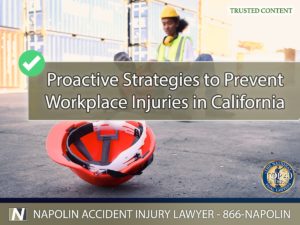Proactive Strategies to Prevent Workplace Injuries in Ontario, California
In California, the diverse landscape of industries presents unique challenges in maintaining workplace safety. From high-tech Silicon Valley offices to Central Valley agricultural fields, each work environment requires tailored strategies to prevent injuries. Understanding and implementing proactive safety measures not only comply with legal standards but also foster a culture of well-being and respect for employees. The commitment to preventing workplace injuries is a shared responsibility, involving meticulous planning, education, and adherence to best practices. Through this article, we aim to guide California workers and employers on effective strategies to minimize the risk of workplace injuries, ensuring a safer and more productive work environment for all.

Empowering Workers Through Knowledge and Preparation
Empowering Workers Through Knowledge and Preparation
Knowledge is the first line of defense against workplace injuries. Employees well-versed in their work environment's specific hazards are better equipped to avoid potential dangers. Regular, comprehensive training sessions tailored to the unique risks of various job roles are essential. These sessions should cover emergency procedures, proper use of safety equipment, and steps to take when a hazard is identified. Additionally, employers should foster a culture of continuous learning, encouraging employees to stay informed about safety innovations and regulatory changes in their industry.
Understanding Workplace Hazards
Identifying potential hazards is a critical step in preventing workplace injuries. Employers must conduct regular risk assessments to pinpoint dangers specific to their operations, whether they involve heavy machinery, chemical exposure, or ergonomic risks in office settings. This proactive approach allows for the implementation of targeted safety measures, such as engineering controls, administrative adjustments, and personal protective equipment (PPE) protocols.
Creating a Safety-First Culture
A safety-first culture is built on the premise that every employee has a role in preventing accidents. This culture is nurtured by leadership's commitment to safety, demonstrated through clear communication, provision of necessary resources for safety initiatives, and recognition of employees who exemplify excellent safety practices. Encouraging open dialogue about safety concerns and suggestions for improvement can lead to innovative solutions that enhance workplace safety.
The Cornerstone of Safety: Equipment and Training
Proper use of safety equipment and thorough training are fundamental to preventing workplace injuries. Employers must ensure that all safety equipment, from hard hats and safety glasses to ergonomic keyboards and anti-fatigue mats, is readily available, properly maintained, and used consistently. Training programs should include hands-on demonstrations, regular refresher courses, and assessments to ensure comprehension and adherence to safety protocols.
Ensuring Compliance with Safety Regulations
Compliance with state and federal safety regulations is non-negotiable. California's Occupational Safety and Health Administration (Cal/OSHA) sets forth specific guidelines that employers must follow to protect their workers. These regulations cover a wide range of topics, including but not limited to, hazardous materials handling, machinery operation, and workplace ergonomics. Employers should conduct regular audits to ensure compliance and address any deficiencies promptly.
Adapting Training to Technological Advances
As technology evolves, so do the tools and machinery used in the workplace. Keeping training programs up-to-date with these advancements ensures that employees are equipped to use new equipment safely. Incorporating virtual reality simulations, online learning modules, and interactive workshops can enhance the effectiveness of training programs, making complex concepts more accessible and engaging for employees.
Body Mechanics and Ergonomics: Keys to Preventing Injuries
Ergonomics and proper body mechanics are crucial in minimizing the risk of musculoskeletal disorders, which are among the most common workplace injuries. Employers should provide ergonomic assessments to customize workstations to fit the needs of individual employees, reducing strain and preventing injuries. Training on proper lifting techniques, posture correction, and the importance of frequent movement can empower employees to take control of their physical health at work.
Implementing Ergonomic Solutions
Ergonomic solutions can range from adjustable chairs and desks to specialized tools designed to reduce strain. Simple adjustments, such as monitor height, keyboard placement, and proper lighting, can significantly impact reducing eye strain, repetitive stress injuries, and back pain. Employers should encourage employees to customize their workspaces to suit their needs and provide resources for ergonomic improvements.
Promoting Regular Physical Activity
Regular physical activity, even in small increments throughout the workday, can prevent injuries by strengthening muscles and increasing flexibility. Employers can promote a more active workplace by providing access to stretch breaks, standing desks, and on-site fitness facilities. Encouraging walking meetings or creating incentives for using stairs instead of elevators are simple strategies to integrate more movement into the workday.
Rest, Recovery, and Awareness: Enhancing Workplace Safety
Fatigue is a significant factor in workplace accidents, making adequate rest and recovery essential components of a comprehensive safety strategy. Employers should enforce policies that allow for regular breaks, adequate meal times, and reasonable work hours. Educating employees on the signs of fatigue and the importance of rest can help prevent burnout and maintain high levels of alertness and productivity.
The Importance of Mental Health
Mental health is equally important in maintaining a safe workplace. Stress, anxiety, and other mental health issues can distract employees from safety protocols and increase the risk of accidents. Employers should provide resources for mental health support, such as employee assistance programs (EAPs), stress management workshops, and a supportive work environment that prioritizes work-life balance.
Encouraging a Restorative Work Environment
Creating a work environment that encourages rest and recovery can significantly impact employee well-being and safety. This includes designing rest areas where employees can relax during breaks, offering flexible scheduling options, and promoting a culture that values time off as a vital aspect of job performance. By recognizing the role of rest in safety, employers can create a healthier, more productive workforce.

A Culture of Safety- Reporting and Addressing Hazards
A Culture of Safety: Reporting and Addressing Hazards
A proactive safety culture encourages the timely reporting and addressing of hazards. Employers should establish clear procedures for reporting safety concerns and ensure that all reports are taken seriously and investigated promptly. This not only helps in mitigating immediate risks but also contributes to a culture of trust and accountability, where safety is everyone's responsibility.
Facilitating Easy Reporting Mechanisms
To encourage reporting, employers should implement user-friendly mechanisms that allow employees to report hazards anonymously if they choose. This could include digital reporting systems, suggestion boxes, or a designated safety officer who is approachable and responsive. Making the reporting process straightforward and non-punitive encourages more employees to come forward with safety concerns.
Learning from Incidents
Every reported incident or near-miss provides an opportunity to learn and improve safety protocols. Conducting thorough investigations to understand the root cause of incidents can lead to significant safety improvements. Sharing the lessons learned from these incidents with all employees can prevent future accidents and reinforce the importance of vigilance and proactive safety measures.
Legal Protection and Advocacy for Injured Workers
Understanding the legal rights of injured workers is crucial in California. Workers' compensation laws are designed to provide support and protection for employees who suffer work-related injuries or illnesses. However, navigating the claims process can be complex and daunting. Seeking knowledgeable legal guidance can ensure that injured workers receive the benefits they are entitled to and understand their rights throughout the process.

Proactive Strategies to Prevent Workplace Injuries in Ontario, California
Proactive Strategies to Prevent Workplace Injuries in Ontario, California
Creating a safe workplace is an ongoing effort that requires the commitment of both employers and employees. By implementing the strategies outlined in this article, California workplaces can significantly reduce the risk of injuries and foster an environment where safety is a shared priority. If you or someone you know has been affected by a workplace injury, Napolin Accident Injury Lawyer is here to help. With a deep understanding of California's legal landscape and a commitment to advocating for workers' rights, our team is dedicated to providing the support and guidance you need to navigate the aftermath of a workplace injury. Contact us at (909) 962-8415 for a free consultation and take the first step towards securing your rights and well-being.
